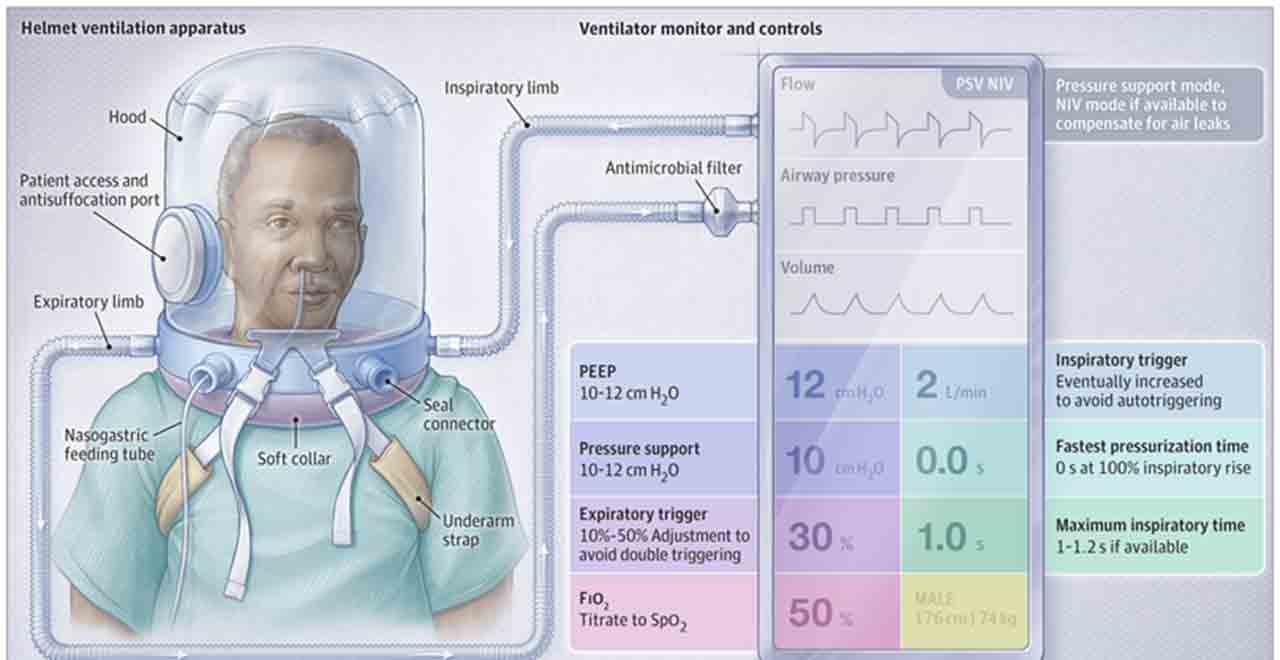Intensivists call it 'helmet' and it is a tool resembling the helmet of space suit that permits to noninvasively support patients with severe respiratory failure, such as those affected by Covid-19 pneumonia, The helmet is manufactured in Italy, and its use is infrequent abroad. A study recently published in the JAMA shows that the 'Italian way' to non-invasive respiratory support - the 'helmet' in fact - may reduce by 40% the need for endotracheal intubation, compared to high-flow nasal oxygen therapy, which is considered the optimal respiratory support in case of hypoxemia.
The main reason for hospitalization and intensive care unit admission of patients with Covid-19 is the acute hypoxemic respiratory failure caused by pneumonia. Based on the results of the HENIVOT study, the authors of the JAMA paper Domenico Luca Grieco and Massimo Antonelli (for the COVID-ICU Gemelli Study Group) suggest that the helmet could be the best way to make these patients 'breathe', reducing the need for intubation and the duration of invasive mechanical ventilation.
«The helmet is an Italian approach. Its use is not frequent abroad, while high-flow oxygen therapy is suggested as the gold standard for these patients and is applied essentially worldwide (as indicated by the 2020 guidelines for patients with severe hypoxemia). The 'helmet' has been used a lot during this pandemic, but mainly in Italy. The great merit of our small pilot trial is that it head-to-head comparison between noninvasive ventilation through the helmet and high flow oxygen therapy, which is a very easy-to-use intervention tool applied in all intensive care units worldwide. The helmet is a different way of helping patients, because it allows noninvasive delivery of high positive end-expiratory pressure, which yields re-opening of the lung affected by the inflammatory process and reduces the respiratory distress perceived by patients.
Previous studies had shown high positive end-expiratory pressure during spontaneous breathing protects the lung from further damage during ventilation. In addition, the helmet is very comfortable compared to other noninvasive ventilation interfaces: this permits continuous treatments with no interruptions, which appear a key factor to successfully avoid intubation. In this study, we compared the effects of high-flow oxygen therapy with those of the helmet noninvasive ventilation, applied continuously for at least 48 hours, with high positive end-expiratory pressure and specific settings. And the results show that the helmet noninvasive ventilation yielded a 40%-relative reduction in the need for endotracheal intubation and invasive mechanical ventilation.
However, patients treated with helmet noninvasive ventilation require close clinical monitoring, as the need for intubation should be identified promptly, and this procedure must not be delayed in failing patents. Intubation delay would otherwise increase mortality. The results of our trial represent another small brick in the wall of the understanding of the pathophysiology of acute hypoxemic respiratory failure: this study represent the tremendous effort of the study group directly involved in facing the emergency setting of COVID-19 pandemic. It is reasonable to hypothesize that the use of helmet noninvasive ventilation, although requiring very experienced personnel and specific settings, can be considered in the intensive care unit and may improve the support of patients with COVID-19 and, possibly, hypoxemic respiratory failure. The results of our study need to be confirmed by studies on larger population. This is a 'proof of concept' study, far from conclusive, which has, however, made known to the world this purely Italian technique for noninvasive ventilation». Domenico Luca Grieco, Intensive Care Physician at Columbus Covid2 Hospital-Fondazione Policlinico Universitario Agostino Gemelli IRCCS, said. The publication in JAMA is accompanied by an editorial that actually opens up to the use of this technique and identifies the novelty of the study.
«The HENIVOT study, which we coordinated, was funded by the Società Italiana di Anestesia, Analgesia, Rianimazione e Terapia Intensiva (SIAARTI) and conducted in collaboration with the Hospital of Rimini and the Universities of Ferrara, Chieti and Bologna. This research and all the efforts made during the pandemic to treat the large number of patients are the results of the enormous teamwork of intensive care physicians, nurses and all the health care personnel involved in the care of patients with Covid-19 in the intensive care units of Policlinico Gemelli and other hospitals involved». Massimo Antonelli, Director of Anaesthesiology, Intensive Care and Clinical Toxicology at the Fondazione Policlinico Universitario Agostino Gemelli IRCCS and Professor of Anaesthesiology and Intensive Care at Università Cattolica, Rome campus said.
The HENIVOT study, was conducted between October 2020 and February 2021 on 109 patients enrolled in some Italian intensive care units and showed that the helmet is the best performing system to assist patients with acute respiratory failure from COVID-19. During the COVID-19 pandemic, Italian physicians were the first to adopt this technique for ventilatory support. Helmets are manufactured in Mirandola, Italy, which represents the 'Silicon Valley' of the Italian electro-medical sector; those used for this study in particular are produced by two companies, Dimar and Intersurgical.
Five great Italian entrepreneurs (Flavio Cattaneo, Luca Cordero di Montezemolo, Diego Della Valle, Isabella Seragnoli and Alberto Vacchi) also believed in the helmets for Covid-19 patients. Last spring, through the association 'Aiutiamoci', which they founded, they purchased and donated several hundred of them to various Italian regions, including Lazio. Part of the 'helmets' used at the Columbus Covid2 Hospital-Gemelli, arrived thanks to this act of generosity. And the intensive care physicians at Columbus Covid2 Hospital-Gemelli, through the study published in JAMA, have shown the world that helmet noninvasive ventilation can be the best way to teat these patients. A true 'Italian way' to respiratory support.



